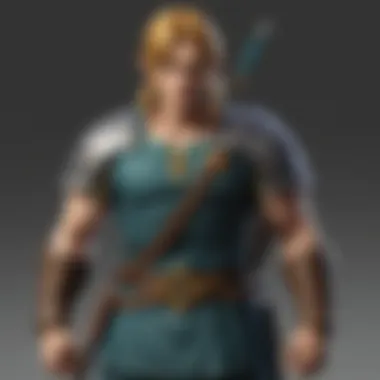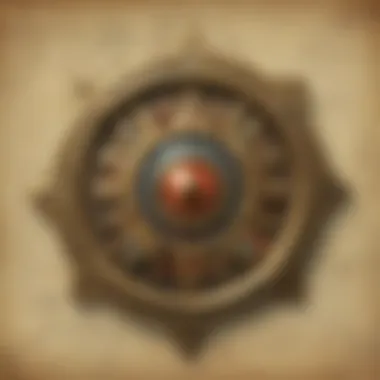Unraveling the Enigmatic Saga of the Legendary Zelda Game Series


Game Reviews
The Legendary Zelda game series has enamored players for decades, captivating them with its intricate gameplay features and immersive world. As players dive into the enchanting realms of Hyrule, they are met with a tapestry of mechanics that challenge and delight in equal measure. From sword combat to puzzle solving, each aspect of gameplay is meticulously crafted to engage and reward players, ensuring an unforgettable gaming experience.
Gameplay Features and Mechanics
Central to the Zelda gaming experience are its rich gameplay features and mechanics. Whether engaging in sword fights with formidable foes or solving enigmatic puzzles scattered throughout Hyrule, players are constantly tested in their strategic thinking and dexterity. The series' signature dungeons present intricate challenges that require keen observation and logical reasoning to conquer, providing a truly immersive gameplay experience.
Storyline and Quests
The narrative tapestry of the Zelda series weaves together intricate storylines and compelling quests that draw players into a world brimming with mystery and adventure. From the timeless battle between good and evil to the poignant relationships between characters, each twist and turn in the plot serves to enrich the player's journey through Hyrule. With quests that range from epic battles to heartwarming character interactions, players are engrossed in a storytelling experience like no other.
Visuals and Sound Design
The visual and auditory aesthetics of the Zelda series are nothing short of breathtaking, immersing players in a world of stunning landscapes and evocative music. From lush forests to sprawling plains, each environment is meticulously crafted to evoke a sense of wonder and exploration. Coupled with a soundtrack that ranges from haunting melodies to adrenaline-pumping battle themes, the visuals and sound design of the series are a testament to the artistry that infuses every aspect of the Zelda universe.
Comparison with Previous Titles
As the Zelda series has evolved over the years, each new installment builds upon the foundation laid by its predecessors while introducing innovative gameplay elements and narrative twists. From the open-world exploration of Breath of the Wild to the dungeon-centric gameplay of Ocarina of Time, each title offers a unique take on the classic Zelda formula. By comparing and contrasting these different iterations, players can gain a deeper appreciation for the series' evolution and the enduring appeal of the Legend of Zelda franchise.
Introduction
Brief Overview of TriforceNet
TriforceNet stands as the ultimate guide for Zelda enthusiasts, serving as a gateway to the vast universe of the Zelda game series. Through detailed analyses, in-depth articles, and comprehensive coverage, TriforceNet aims to cater to both seasoned fans and newcomers alike, providing a platform to unravel the secrets and intricacies of Hyrule.
Target Audience of TriforceNet
The target audience of TriforceNet encompasses a diverse group of individuals united by their love for the Zelda game series. From hardcore gamers seeking expert insights to casual fans looking to deepen their understanding, TriforceNet is designed to engage, enlighten, and entertain all aficionados of Link and Zelda's epic adventures.
The Origins of Zelda
The section focusing on The Origins of Zelda delves into the inception of the beloved game series, shedding light on its foundational elements and overarching significance. From the creative genius of Shigeru Miyamoto to the evolution of gameplay mechanics, this segment serves as a crucial entry point to understanding the essence of Zelda. By exploring the roots of the franchise, readers can grasp how pivotal moments in development and design have shaped the iconic universe.
Creation of the Zelda Universe


The Vision of Shigeru Miyamoto
The Vision of Shigeru Miyamoto stands as a cornerstone of The Origins of Zelda, symbolizing innovation and creativity in game design. Miyamoto's distinctive approach emphasized immersive storytelling, intricate world-building, and multifaceted characters. This visionary outlook paved the way for Zelda's distinct charm and enduring appeal. Despite facing constraints and technical limitations of the time, Miyamoto's vision transcended traditional gaming norms, revolutionizing how players interacted with virtual worlds. The fusion of exploration, discovery, and adventure exemplified in Miyamoto's vision continues to captivate audiences and set new standards for game narratives.
Evolution of Gameplay Mechanics
The Evolution of Gameplay Mechanics represents a pivotal aspect of Zelda's evolution, demonstrating a commitment to pushing boundaries and redefining player experiences. From rudimentary controls to sophisticated combat systems, every iteration of Zelda has strived to refine and enhance gameplay mechanics. Innovations such as lock-on targeting, contextual actions, and dynamic puzzles showcase a dedication to providing a seamless and engaging gameplay journey. While each mechanic iteration has its strengths and limitations, the series' ability to adapt and innovate underscores its enduring relevance in the gaming landscape.
Impact on Gaming Industry
Cultural Phenomenon
The Cultural Phenomenon surrounding Zelda transcends mere entertainment, encapsulating a zeitgeist of creativity, passion, and communal engagement. Zelda's iconic status within the gaming industry is not merely due to its popularity but also its profound cultural impact. Its themes of heroism, destiny, and perseverance resonate with players on a deep level, fostering a sense of connection and nostalgia. The franchise's ability to inspire fan creations, discussions, and events underscores its importance in shaping gaming culture.
Trailblazing Innovation
Trailblazing Innovation has been a hallmark of Zelda's contribution to the gaming industry, with each installment introducing groundbreaking ideas and mechanics. Whether through pioneering open-world structures, interactive narratives, or unconventional gameplay elements, Zelda has consistently challenged conventions and set new benchmarks for game development. The innovative spirit of the series has not only influenced game design trends but has also inspired a new generation of developers to push the boundaries of what interactive storytelling can achieve.
Exploring the Gameplay
In this detailed exploration, we delve deep into the intricate gameplay of the legendary Zelda series, shedding light on its fundamental elements and strategic nuances. Exploring the Gameplay section serves as a cornerstone in this article, offering invaluable insights into the immersive world of Zelda. By dissecting the puzzle-solving components, combat strategies, and character interactions, we aim to provide a holistic view of the gameplay dynamics that captivate players worldwide.
Puzzle-Solving Elements
Dungeon Challenges:
Embark on a quest through the labyrinthine Dungeon Challenges, a staple feature of Zelda's gameplay. These challenges not only test the players' cognitive abilities but also immerse them in a world of mystery and strategy. The key characteristic of Dungeon Challenges lies in their intricately designed levels, riddled with traps and puzzles that require astute problem-solving skills to overcome. Its allure as a popular choice in this article stems from its ability to engage players in critical thinking and exploration, enhancing the overall gaming experience. Despite their allure, Dungeon Challenges can be time-consuming and may pose difficulty spikes, adding a layer of complexity that both challenges and enthralls players.
Brain-Teasing Puzzles:
Navigate through the realm of Brain-Teasing Puzzles, another hallmark of Zelda's gameplay experience. These puzzles serve as mental obstacles that players must solve to progress, testing their analytical skills and wit. The key characteristic of Brain-Teasing Puzzles is their ability to ignite the players' problem-solving abilities, fostering a sense of accomplishment upon completion. Their popularity in this article is due to the intellectual stimulation and satisfaction they provide to players. However, the intricate nature of these puzzles may lead to moments of frustration and confusion, requiring patience and perseverance to conquer.
Combat Strategies
Delve into the realm of Combat Strategies, a crucial aspect of mastering the Zelda series. From honing the art of Swordplay to strategizing Boss Battle Tactics, players must adeptly navigate the challenges that combat presents.


Mastering Swordplay:
Master the art of Swordplay, a fundamental skill that determines success in combat encounters within the Zelda universe. The key characteristic of mastering Swordplay lies in its emphasis on precise timing and swift reflexes, enabling players to execute intricate moves with finesse. The appeal of Swordplay in this article lies in its intricacy and the satisfaction derived from mastering a skill essential to progression. However, mastering Swordplay requires dedication and practice, as mistimed strikes can lead to dire consequences in intense battles.
Boss Battle Tactics:
Strategize your approach to Boss Battle Tactics, where players face off against formidable foes requiring skill and strategy to overcome. The key characteristic of Boss Battle Tactics is the strategic decision-making involved in identifying enemy weaknesses and exploiting them for victory. The allure of this aspect in the article stems from the thrill of facing mighty adversaries and the strategic depth it adds to the gameplay experience. However, mastering Boss Battle Tactics demands patience and adaptability, as bosses often present unique challenges that require varied approaches for success.
Unraveling the Lore
In this segment of the extensive discourse on the enigmatic Zelda game series, we delve into the crucial aspect of unraveling the lore that underpins the fascinating universe of Hyrule. Unraveling the lore is paramount as it offers aficionados a deep insight into the intricate narratives, mythologies, and histories that shape the world of Zelda. Understanding the lore provides players with a comprehensive appreciation of the characters, settings, and events that unfold across the myriad titles in the series. This section serves as a key cornerstone, shedding light on the mythology and significance that form the bedrock of the Zelda experience.
Legendary Characters
Link: The Hero of Time
Link, often heralded as the Hero of Time, stands as a central figure in the Zelda saga, embodying bravery, resilience, and heroism. His timeless quest to vanquish evil, save Princess Zelda, and restore balance to Hyrule resonates with players worldwide. Link's unwavering dedication to his cause, coupled with his mastery of weaponry and courage in the face of adversity, makes him a compelling and iconic character. Within the context of this article, Link's role is integral to unraveling the mysteries of the Zelda series, as his tale intertwines with the fabric of Hyrule's lore.
Princess Zelda: The Wise Ruler
Princess Zelda, known for her wisdom, grace, and royal lineage, assumes a pivotal role in the Zelda universe. As a sage ruler and custodian of the Triforce of Wisdom, Zelda brings a unique perspective and strength to the narrative. Her timeless bond with Link and her innate ability to guide him through his quests add depth and complexity to the overarching storyline. Within the framework of this exploration, Princess Zelda's character offers a counterbalance to Link's heroism, showcasing a harmonious duality that elevates the Zelda saga to greater narrative heights.
Mythical Artifacts
The Master Sword
The Master Sword, a legendary blade of unparalleled power and significance, serves as a linchpin in the Zelda mythos. Its ability to vanquish evil, pierce through darkness, and aid the chosen hero in moments of great peril makes it a vital artifact in Hyrule's history. The sword's symbolism of courage, wisdom, and power resonates throughout the series, embodying the enduring spirit of good triumphing over evil. Its inclusion in this article underscores its pivotal role in shaping the destinies of Link, Zelda, and the realm of Hyrule.
The Triforce
The Triforce, a mystical relic comprising the virtues of Power, Wisdom, and Courage, holds immense importance in the Zelda narrative. Its omnipotent nature and the coveted desire it elicits from both protagonists and antagonists underscore its pivotal role in the series. The Triforce's role in the eternal struggle between light and darkness, its ability to shape destinies, and its symbolic resonance with the core themes of the Zelda series make it a central element in the lore of Hyrule. In dissecting this enigmatic artifact, we unravel layers of complexity and significance woven into the fabric of Zelda's enduring legacy.
Changing Narrative Themes
Exploration vs. Linearity


The exploration vs. linearity debate within the Zelda series lies at the core of its evolving narrative structure, offering players a balance between open-world exploration and structured storytelling. Exploration allows players to roam vast landscapes, uncover hidden secrets, and forge their path through Hyrule, embodying the spirit of adventure and discovery. In contrast, linearity provides a more guided experience, leading players through a predefined sequence of events and encounters to drive the central narrative forward.
A key characteristic of exploration in Zelda games is the freedom it affords players to chart their course and uncover untold stories scattered throughout the game world. By integrating non-linear narrative elements, dynamic events, and environmental clues, exploration enriches the player's immersion and fosters a sense of agency, encouraging divergent gameplay experiences tailored to individual preferences. The unique feature of exploration lies in its ability to reward curiosity, incentivizing players to explore every corner of Hyrule in search of hidden treasures and meaningful connections that enrich the overarching story.
On the other hand, linearity ensures a more focused storytelling experience, guiding players through carefully crafted narratives, set-piece encounters, and character development arcs that propel the game's overarching themes. By maintaining a clear narrative direction, linearity can deliver a cohesive and emotionally resonant story that immerses players in a compelling dramatic arc filled with twists, revelations, and character growth. The balance between exploration and linearity is a delicate one, requiring developers to design gameplay experiences that cater to different player preferences while ensuring a cohesive and satisfying narrative structure.
Character Development
Character Development in Zelda games plays a vital role in shaping the emotional depth and thematic richness of the series, offering players compelling narratives, memorable interactions, and layered personalities that resonate beyond gameplay. By focusing on the growth, conflicts, and motivations of key characters such as Link, Zelda, and Ganon, Character Development weaves a tapestry of interconnected stories that elevate the player's connection to the game world and its inhabitants.
A key characteristic of character development is its ability to humanize the heroes, villains, and allies within the Zelda universe, transforming them from archetypal figures into multidimensional personalities with their fears, aspirations, and moral dilemmas. Through meaningful character interactions, moral dilemmas, and personal growth arcs, players are invited to empathize with the struggles and triumphs of characters, forging emotional bonds that deepen their immersion in the game world. The unique feature of character development lies in its capacity to blend gameplay mechanics with narrative depth, providing players with an emotional investment in the unfolding events and character dynamics.
Despite its benefits in enhancing player engagement and narrative complexity, character development can present challenges in maintaining consistency across multiple titles, providing meaningful character arcs for secondary characters, and balancing individual growth with the series' overarching mythology. Developers must craft compelling storylines, believable character motivations, and organic interactions to ensure that character development enhances the player's emotional connection to the game world while staying true to the established lore and thematic conventions of the Zelda universe.
Impact on Pop Culture
Fan Community
Cosplay Events
In the realm of the fan community, events like Cosplay hold a special place in celebrating the Zelda series. Cosplay allows enthusiasts to embody their favorite characters from Hyrule, fostering creativity and community bondings. Attendees meticulously craft costumes, paying homage to the iconic figures of the game. This participation not only showcases dedication to the series but also serves as a platform for fans to express their admiration for Zelda in a tangible, interactive manner. Despite the time and effort required for Cosplay, the experience of immersing oneself in the Zelda universe through detailed costumes and role-playing brings a unique sense of enjoyment and fulfillment, enriching the overall engagement with the game.
Fan Theories
Moreover, fan theories surrounding Zelda add another layer to the community's dynamics. Enthusiasts passionately dissect and interpret storylines, characters, and hidden messages within the games, contributing to a robust culture of speculation and analysis. These theories, whether plausible or outlandish, spark debates, fuel creativity, and keep the fan base engaged long after completing the games. Embracing fan theories not only deepens the gaming experience but also fosters a vibrant community where ideas are shared, debated, and celebrated, enriching the collective understanding and appreciation of the Zelda series.
References in Media
Music and Films
The intertwining of Zelda with music and films signals its enduring impact on various media formats, further solidifying its presence in pop culture. Through musical adaptations, film references, and thematic inspirations, Zelda's influence reaches beyond gaming into realms of audiovisual artistry. The emotive scores composed for the games evoke a sense of nostalgia and adventure, resonating with audiences on an emotional level. Likewise, films referencing Zelda themes imbue popular culture with elements of heroism, fantasy, and epic journeys, drawing parallels between the games and cinematic narratives. The fusion of Zelda with music and films not only broadens the series' reach but also underscores its status as a staple in contemporary pop culture.
Merchandising
Simultaneously, merchandising based on Zelda embodies its commercial viability and enduring appeal to fans of all ages. The availability of themed merchandise, from clothing to accessories, extends the Zelda experience beyond gaming consoles, allowing enthusiasts to integrate their passion for Hyrule into their daily lives. Merchandising serves as both a marketing strategy and a form of fan engagement, catering to a diverse audience seeking tangible connections to the beloved series. While the proliferation of Zelda merchandise offers fans an opportunity to showcase their allegiance, it also prompts critical discussions on consumerism, brand representation, and the intersection of art and commerce within the pop culture landscape.
Conclusion
Additionally, the [Conclusion] serves as the ultimatum to the elucidation of abstruse concepts and enigmatic facets uncovered thus far. Through a judicious synthesis of the unveiled mysteries, it cements the reader's grasp of the overarching themes and pivotal elements intertwined within the Zelda saga. Moreover, it offers a nuanced perspective aimed at illuminating subtle nuances often overlooked amidst the grandeur of legend and folklore. What distinguishes the [Conclusion] within [this article] is its innate ability to transcend mere summation, transcending into a contemplative realm where conjecture impels discourse and speculation feeds curiosity. Rendering closure to each embarkation through the enchanted realm of Hyrule, it resonates with both neophytes seeking insight and veterans relishing nostalgic echoes of past encounters. Ultimately, the [Conclusion] encapsulates the soul of Zelda, immortalizing its legacy in the annals of gaming history.
Final Thoughts
Resonating with the cadence of an oracle's whisper, the [Final Thoughts] echo the sentiment of closure and revelation. Within the delineations of this segment lies a crystallization of emotions and ruminations conjured by the saga of Zelda. Emerging as the harbinger of contemplation and introspection, it bespeaks volumes on the impact of gaming and storytelling amalgamate, creating a symbiosis of art and technology that defines the genre. At its core, the [Final Thoughts] expound upon the enduring legacy of Zelda, transcending the confines of mere entertainment into the realm of cultural immersion and narrative prowess. Each word penned in this epilogue carries the weight of reflections sired from battles won, secrets unveiled, and friendships forged within the digital expanse of Hyrule. Moreover, the [Final Thoughts] effervesce with poignant tributes to the game's profound influence on pop culture, community engagement, and intergenerational camaraderie. It is a testament to the resilience of a narrative woven with threads of courage, wisdom, and enduring bonds that resonate across time and space. Through this culminating discourse, the Zelda saga transcends its digital confines, imprinting itself upon the hearts and minds of all who dare to embark on this legendary odyssey.







